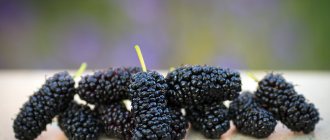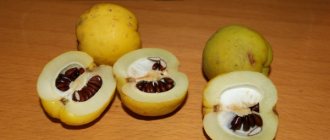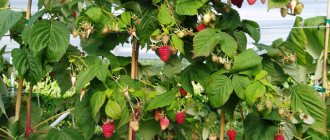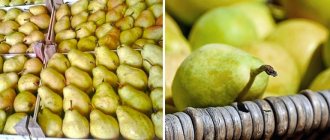Encyclopedia of Plants
Homegrown apricot is delicious, bursting with juice and delicate flavors. Picked straight from the tree, it tastes better than store-bought. Many modern varieties have been bred to grow reliably in cooler climates. They can be grown as fruit trees or ornamental bushes, and there are even dwarf varieties for pots.
- 1 Description of the fruit crop 1.1 Advantages of planting an Apricot tree on a hill or in a “bed”
- 3.1 Planting an Apricot pit in a pot
- 5.1 Why apricot fruits rot on a tree and what to do
Description of fruit crop
Apricot is a tree crop with plum-shaped fruits of sunny color. The culture spreads well in mid-latitudes. One of the reasons for this interest is the great demand for juicy fruits among the population. The interest in apricots is not accidental. They contain vitamins of almost the entire available group: B, D, C, E. List of organic acids: tartaric, citric and malic. In addition, apricots contain pectin, carotene, iron, copper, zinc, magnesium, glucose and sugar. The fruits are tasty, healthy, they improve health and prevent many diseases. Thanks to breeding scientists, apricot varieties have been developed that are adapted to more severe growing conditions. Apricot trees are short and have broad, ovate foliage with sharp tips.
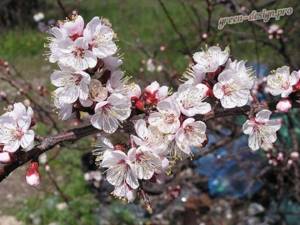
Apricot blossom
The leaves are bright green. Self-pollinating flowers are usually white. Depending on the variety, the size of the apricot tree varies in the range of 5-8 meters. The crown is round, lushly dotted with ovoid, succulent leaves, the length of which is about 6-9 cm. The fruits are almost smooth, round or oblong. The trees are quite drought-resistant and in favorable conditions some apricot trees live 100 years or longer. Apricot was originally domesticated in China and is now grown on every continent except Antarctica.
You may like the article “Growing a peach tree on a personal plot”
Advantages of planting an Apricot tree on a hill or in a “bed”
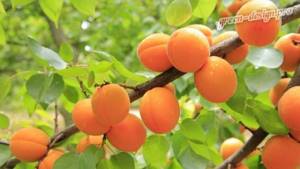
- There is no overheating of the bark at the base and better preservation of flowers in frost is ensured.
- The roots are located in soil that is heated to the height of the flowerbed. Growth and development are not impaired.
- Early growing season. After the snow melts, the spring sun warms up the flowerbed earlier. All growth processes, including the accumulation of nutrients before winter, occur fully and in a timely manner.
- The first autumn frosts harden the roots in the cooled flower bed. The plant finishes growing in a timely manner.
- Faster evaporation of moisture. Root rot is prevented.
Despite its heat-loving nature and apparent capriciousness, apricot is a hardy plant. Cherries and plums, traditional for the middle zone, are much more difficult to care for. They have a lot of diseases and pests.
How does apricot bloom?
Apricot blossoms are one of the signs of the coming spring. Apricot trees bloom even before the leaves bloom. First, swollen pink buds appear on the trees, which then turn into pink or white fragrant flowers with pink veins.
Video: apricot blossoms
What color does apricot bloom?
Apricot flowers are single, with five petals, large, 25–30 mm in diameter, white or pale pink. The calyx of the flower is small, fused, with five dark red reflexed sepals. It falls off along with the stamens and pistil after fertilization occurs. From 20 to 30 stamens are located inside the flower in several rows.
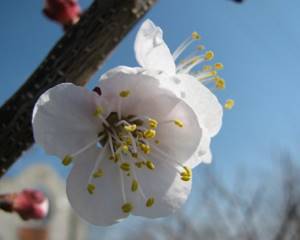
Apricot flowers are white with pink veins or pink
How many days does apricot bloom?
The beauty of flowering apricot trees can last up to 10 days.
At what temperature does apricot bloom?
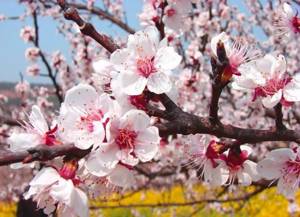
The friendly flowering of apricots begins at temperatures above +10C
The awakening of flower buds occurs already when the temperature rises to +50C. If it occurs for a short time, then the kidneys freeze again. If the temperature persists for a long time, flowering begins. The sum of effective temperatures exceeding the threshold of +50C for the beginning of apricot flowering should be equal to 3000C.
For apricot trees to bloom, temperatures above +100C are required. Ideally, this should be a temperature of +17, +190C in calm weather without strong wind. Such conditions are optimal for the fertilization process, and bees are then most active. In reality, the temperature range ranges from +7 to +280C. As a result, the fruit harvest will be unstable.
Planting and growing an apricot tree
This culture is interesting for private gardening. Many people are interested in planting and growing it.

As for planting, it should be planted in the brightest place in the area.
A light-loving crop should be in the sun to the maximum, preferably all daylight hours.
If the site has slopes, then the highest point is selected for planting. If there are buildings, fences, or other architectural forms, the apricot is placed on the south side. So, they will receive sufficient illumination, plus they will be protected from northern winds. A biologically suitable indicator for planting will be the presence of earthworms and nearby voluminous trees (pear, oak, ash, maple). All of these trees have deep root systems. The central regions are dominated by cold and infertile soils. Therefore, it is better to plant an apricot tree not in a planting hole, but in an elevated flower bed. For one tree it is made from the following calculation: 0.7 meters – height and 2.5 meters diameter. In case of heavy clay soil, it is recommended to pour coarse sand with fine gravel to form a flower bed to a thickness of 10 cm. The ratio of sand and gravel should be 1 to 10. It would be nice to sprinkle 1 cm of wood ash on the same layer, and make the final covers of 30 cm from rotted manure and fertile soil, to which potassium sulfate (25 g per 1 m2) and superphosphate ( 50 g per 1m2). If the soil at the intended planting site is sandy, then the flowerbed begins to be organized with a layer of clay peat - to retain fertilizers and moisture. These first 10 cm should be in a ratio of 1 to 1. Subsequent layers are the same as for clay soil. In any case, the flower beds are prepared in the fall, and apricot seedlings are planted in early spring. Planting is done as follows: in the center of the flowerbed, dig a hole to the width and depth of the roots, place a tree in it, sprinkle it with earth, drive in a wooden peg, to which the apricot is tied and a kind of watering ditch is made. Its depth is 20 cm. Diameter is about a meter.
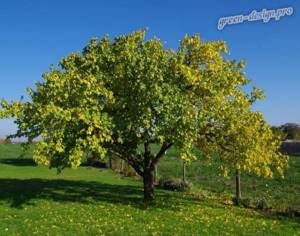
Carry out the first and subsequent watering abundantly without fertilizers. They will need to be applied only in the second year after planting. Usually during this period the plant’s survival rate ends. In general, apricot will grow and bear fruit successfully where the average daily temperature is always above 10 degrees. The most suitable soils for apricot are those that are light, warm and drain well. It is desirable that groundwater lies at least 4–5 meters from the surface. In order to prevent the flowerbed from shedding and to naturally replenish the tree with nitrogen, white clover or fescue should be planted on it. Every three months this grass is mowed, leaving a slope that prevents shedding.
Why doesn't apricot bloom?
For apricot to bloom you will need:
- purchase a seedling of a variety that suits the climate and growing conditions in its future location;
- provide all the tree’s needs for protection from wind, soil quality, lighting, etc.;
- prune the plant, fight diseases and pests (but do it competently and in a timely manner);
- systematically (but not excessively) fertilize the apricot with all the necessary fertilizers.

Important! Flowering is a harbinger of fruit formation. Therefore, if the question arises of how to make an apricot bear fruit, it is enough to wait for it to “grow up” (age 4-5 years) and provide it with all the conditions described above.
However, it also happens that the gardener did everything according to the rules: he selected the right variety for his area, chose the right place, and adhered to agricultural practices when planting, but after several years the tree still does not bloom. In such cases, there may be several reasons (cold, age, diseases and pests, growing conditions), by eliminating which you can achieve abundant flowering and fruiting.
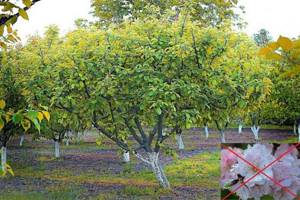
Cold
Cold can mean several different things. Of course, it is unlikely that anyone will plant a fruit tree in a harsh climate or in permafrost conditions. However, in some regions, cold and frosty winters may occur periodically, which leads to the cancellation of flower formation. It is likely that the kidneys froze and therefore were unable to perform their functions.
The apricot tree prefers to grow in warm conditions, so if it is planted in the wrong place, it may not bloom. A possible cause is frozen ground or cold piercing wind.
Age
Various sources vary in what year the apricot begins to bear fruit, however, on average, the fruiting period begins at the age of 3 to 8 years. Accordingly, the tree will begin to bloom and bear fruit around this period. Due to certain circumstances, some apricots may “ripen” a little later.
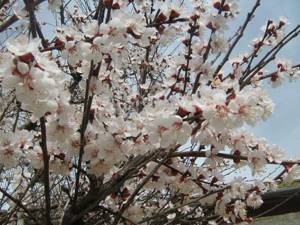
Diseases and pests
Another reason for the lack of flowering in an apricot tree is an infectious disease that depletes the tree, called gum disease or gomoz. The plant produces so-called tears, consisting of a viscous liquid, on its trunks, fruits and branches. This disease can be caused by sunburn (or, conversely, frostbite), improper pruning, or harmful insects.
Growing conditions
Apricot trees prefer to grow in sunny places with nutritious soil that allows water and air to pass through well. However, you need to ensure that the groundwater level is at least two meters from the ground surface. Trees also require regular feeding: mineral fertilizers need to be applied twice a year, and organic fertilizers four times a year.
If a tree does not receive enough sunlight, then it spends most of its energy trying to reach the sun. In this regard, apricots that grow in the shade cannot bloom and, therefore, form fruits.
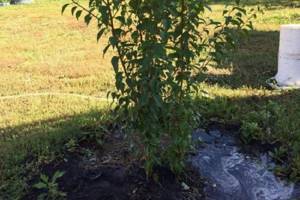
How to grow Apricot from a seed in a pot at home
- Remove the seed from the fruit. Carefully cut the apricot in half. Open the pulp and remove the seed. Rinse it under cold running water to remove all the pulp. Dry the pit with a paper towel.
- Preparing the soil for planting Apricot . Mix one part moist sphagnum peat, one part coarse sand and one part perlite or vermiculite. If you do not want to prepare the soil mixture, you can buy it at any garden store. Take a medium-sized thick plastic bag with a zipper and fill it two-thirds with the prepared soil mixture. Moisten the mixture with a small amount of water and shake the bag so that the moisture is evenly distributed in the container.
- How to split an Apricot seed. Place the pit in the prepared soil and place it all together in a plastic bag, squeezing it to remove all the air from the bag, sealing it securely. Keep the bag in the refrigerator for four weeks. This process is called "cold stratification" and mimics what a seed would go through under natural conditions. After four weeks of cold treatment, the seeds will be ready to germinate.
Planting an Apricot pit in a pot
At the end of the four weeks of “cold peeling,” remove the seeds from the sprouting mixture and rinse with cold water.
- Carefully crack open the hard outer shell using a nut cracker. Do not use too much force as this may damage the core inside. Don't open the bone
- Use the sprouting mixture from the bag to fill a medium pot to within 2cm of the top.
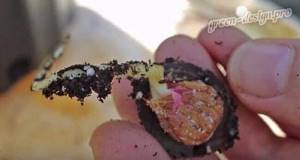
Place the cracked seed in the center of the sprouting mixture, pushing it down 2-3cm. Place the pot in the sink and water until water comes out of the bottom drainage hole. Stop watering and allow excess moisture to drain for one hour. - After an hour, cover the top of the container with plastic wrap and seal the edges tightly. This will help keep the soil constantly moist.
- Place the pot in a sunny location where it will receive indirect sunlight. Avoid direct sunlight as this may cause the soil to heat up too much.
- Keep the soil moist. It will take 4-6 weeks for sprouts to appear. When the sprouts appear, remove the plastic film and move the pot to the sun, preferably on the south side.
- The apricot seed will develop its root system and should be transplanted into a larger container after 4-6 weeks.
Choose a pot that will become a permanent home for your apricot tree. Capacity or container 50cm. diameter is ideal for growing apricots. Fill the pot with a purchased potting mix that has a neutral pH of 6 to 6.5.
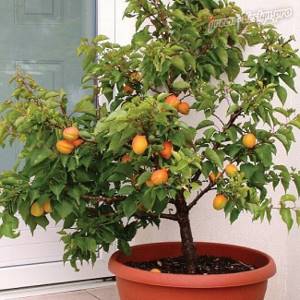
You can make your own soil mixture from equal parts sphagnum peat moss, sterilized topsoil, sand and vermiculite or perlite. However, getting the pH value right can be a little tricky.
Ways to delay apricot flowering
With a later flowering period, the likelihood of frost decreases, thus it is possible to preserve more ovary and increase the yield of apricots. How to do it? There are several practice-tested answers to this question:
- Summer pruning. Pruning young branches carried out from mid-May to early June will delay the development of secondary shoots and stimulate the formation of flower buds on second- and third-order branches. This will ensure that flowers bloom later in the spring. The shoots need to be cut to one third of their length.
- Graft. This method is more complicated, especially for novice gardeners. An early-blooming apricot should be grafted onto a late-blooming plant. It is better to choose a rootstock among apricots, cherry plums, plums, sloe, sand cherry, and zherdels (wild apricots).
- Mulching with sawdust. To perform protection, the tree trunk circle is mulched with manure or peat. Then the snow is raked under the tree and compacted (layer up to 30 cm). It is sprinkled with sawdust and covered with snow again. As a result, the sawdust freezes into a single layer, which will delay the melting of snow in the spring. In cold soil, the root system will awaken later, which means the flowering of the tree will be delayed.
- Whitewashing the trunk with slaked lime with the addition of manure or clay. It will prevent the trunk from heating up in the first sun and will delay the blooming of the buds.
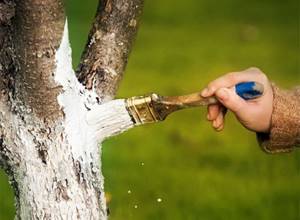
Whitewashing the trunk with slaked lime with the addition of manure or clay will delay the flowering period of apricots
- Water the soil abundantly in the fall before frost. In this case, the soil under the tree freezes more strongly and will thaw more slowly in the spring, delaying the flowering of buds. Watering the tree with cold water in early spring has a similar effect.
- Sprinkling in early spring. Trees can be sprayed with clean water as soon as the temperature drops to 0 ºC. You need to repeat the procedure several times so that the entire tree is covered with a thin protective crust of ice. This ice layer will protect the buds and shoots from frost.
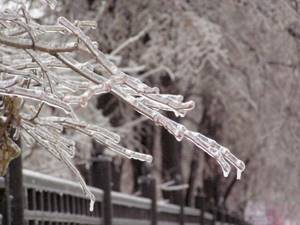
Ice glaze protects buds from frost
- Spraying the crown. It is carried out before the buds open in early spring. For this, various preparations are used: saturated salt solution (0.7 kg per 10 liters of water);
- urea (0.7 kg) with copper sulfate (0.05 kg) per 10 liters of water;
- three percent Bordeaux mixture (0.3 kg of copper sulfate and lime dissolved in 10 liters of water);
- iron sulfate (0.4 kg of substance per 10 liters of water);
- urea with ferrous sulfate (dissolve 0.5 kg of urea and 0.05 kg of sulfate in 10 liters of water).
Apricot tree diseases
For apricots, two diseases pose a serious danger:
- The first disease is moniliosis. It causes flowers and shoots to dry out and the fruits themselves to rot.
- The second disease is clustersporiosis. Brown spots appear on the leaves, which turn into holes.
Apricots, of course, have other diseases, but in the middle zone only these are observed. They are caused by rain and long-term cloudy weather. To prevent diseases, you need full care and protection.
Often, fruit is susceptible to fungal diseases that develop due to improper location, excessive soil moisture, etc. Let's look at the most common causes of illness.
Why do apricot fruits rot on a tree and what to do?
The cause of the disease is gray rot of stone fruits, which is a rapidly spreading disease. It is accompanied by the appearance of small gray ulcers on the surface of the fruit. You can combat the problem by spraying before and after flowering with a one percent solution of Bordeaux mixture. It is also recommended to spray the branches with Natrafen in spring.
Rotting can also cause clusterosporiasis, characterized by massive spread to the branches and fruits of the fruit. The method of combating is the same as with gray mold.
Why does the apricot tree dry out?
There may be several reasons for this:
- Apoplexy is a bacterial infection caused by warm winters and spring frosts. Due to unfavorable weather conditions, the internal cells of the fruit die, causing the gradual death of the shoots.
- Moniliozone is a burn of the surface of a plant caused by weather changes in spring. Symptoms of the disease are drilling, drying of foliage and shoots. Subsequently, fruit rot develops. As a control and prevention, a three percent solution of Bordeaux mixture is used. At the first symptoms, the fruit must be treated with Topaz or Topsin-M. Damaged shoots must be removed.
- Cytosporosis is a fungal disease manifested by the appearance of numerous gray-brown tubercles on the bark of a tree. The disease causes the foliage and branches to dry out. As a preventive measure, a solution of Bordeaux mixture is used, and the affected areas are destroyed.
It should be noted that, despite the abundance of various diseases, the main component of the success of a bountiful harvest and healthy fruit is regular prevention.
Flowering time
The southern apricot blooms before everyone else, without waiting for stable heat. Flowering times differ in different regions - the further south, the earlier. Everything depends primarily on the weather of the current year, and sometimes even on the microclimate of a particular area: it happens that apricots in one place have already faded, while in another the first timid flowers are just blooming. In any case, the blooming of apricot trees is a convincing sign of the beginning of spring. However, it is still a long way from its complete dominion; at this time, night frosts and recurrent frosts are still possible.
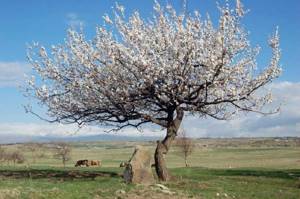
Apricot blooms very early, when the first leaves are just beginning to bloom on the trees.
Even a short-term cold snap can significantly affect the future harvest. Apricot flowers and ovaries, significantly damaged by frost, fall off the tree. Those that are less affected often develop deformed fruits that are unsuitable for consumption.
The influence of temperature on the growth of flower ovaries
Scientists have long been interested in the question of how the buds, buds, flowers and ovaries of fruit trees tolerate low temperatures. The data obtained turned out to be very interesting:
- The stability of the buds and flowers of a fruit tree has nothing to do with its resistance to winter frosts.
- Blooming apricot and even peach flowers can tolerate lower temperatures than apple blossoms.
- The resistance of flowers to low temperatures depends on the weather conditions at the time of their opening. Fruit tree inflorescences that bloom in cold weather can tolerate lower temperatures than those that bloom on a warm day.
- Different flower elements have different degrees of resistance to low temperatures: the flower pistils suffer the most, while the anthers are the most resistant to cold. This is typical not only for apricots, but also for other stone fruits.
- A strong, but short-term drop in temperature is less dangerous for flowering trees than a weak, but longer drop.
- For apricot buds, negative temperatures from -1.1 to -5.5 ºС can be fatal, for blossoming flowers - from -0.5 to -2.75 ºС, for a formed ovary - from 0 ºС to -2.2 ºС. That is, the fruit ovaries are the most vulnerable to freezing.
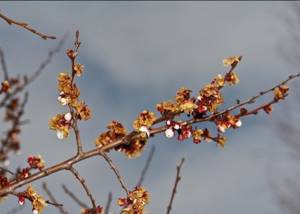
Unopened apricot buds tolerate frost better than flowers that have already fully bloomed
People have long noticed that during the flowering period of garden trees there is always a drop in temperature, and even frost. Most often, it is apricots that get cold shock, because they bloom earlier than everyone else, during the period of least stable heat.
Apricot tree varieties
The varietal composition of the apricot fruit tree is enormous. Let us list those varieties that have proven themselves best in our latitudes:
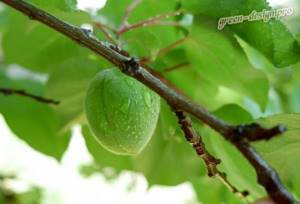
- Early ripening: June early, Tsunami, Early Blush, Alyosha, Sambursky early, Chervnevy. Apricot early, Veteran of Sevastopol, etc.
- Mid-season: Reliable, Red-cheeked, Polessky large-fruited, Michurinets, Shalamark, Tsegledi Biber, Goldridge, Zaporozhets, Dessert and others.
- Late-ripening: Ogonyok, Kievsky Krasen, Favorite, Kievsky Cannery, Kostyuzhensky, Sirena, Surprise, Honey, Iskra and others.
Apricot early
Early varieties of apricots are not afraid of frost. With proper care you can get a productive harvest. The following varieties are classified as early varieties.
Lel
The crown of the tree is small and not susceptible to disease. Its fruits have a neat, attractive appearance, they are not large at all - they weigh up to 20 g. They have a dense skin, soft, juicy pulp, sweet, melt in the mouth. The bone is easily removed. Early varieties of apricots produce a good harvest, so they are not a bad business for gardeners.
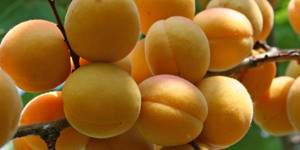
Honey
Growing this variety of early apricot is not burdened with difficulties - the tree has good immunity from various diseases, and the variety is frost-resistant. Small dense fruits of bright yellow color, very tasty. The skin has characteristic dark red patches. Honey apricot does not grow very large, so it is very easy to care for in the garden.

Tsarsky
Early fruiting, which is best not grown in regions with short, cold summers. The tree grows tall. The fruits weigh 20-24 g, they are quite dense and have a thick skin. Tsarsky is a transportable variety and can last for a long time if properly stored in a cool place. Resistant to various diseases.
Early Tsarsky - distinguished by early fruiting. The fruits have a soft, delicate texture, a characteristic aroma, and a sweet taste. In use – suitable for preserving and making jam.

The value of culture
Apricot fruits are consumed fresh, dried, and also used for canning: they are processed into marmalade, marshmallows, jam, filling for candies, etc. They are also used to make juices, wines and liqueurs (there is even a special type of liqueur - apricotine). The fruits are used for drying mainly in Uzbekistan and Tajikistan. Dried fruits without seeds, in the form of halves, are called dried apricots, and with seeds - apricots (in Central Asia, the word “apricot” is the main name for apricot).
Apricot fruits occupy one of the first places among fruit species in terms of nutritional and medicinal value.
There is evidence that they contribute to the preservation of youth and, in general, longevity, and at the same time have a wonderful taste. Observation of the diet of the inhabitants of the Indian Hunza Valley and one of the Pakistani tribes, where the average life expectancy is 85-90 years, showed that apricot occupies the main place among their food products. Something similar is observed in other regions where fresh or dried apricots are regularly used as food.


